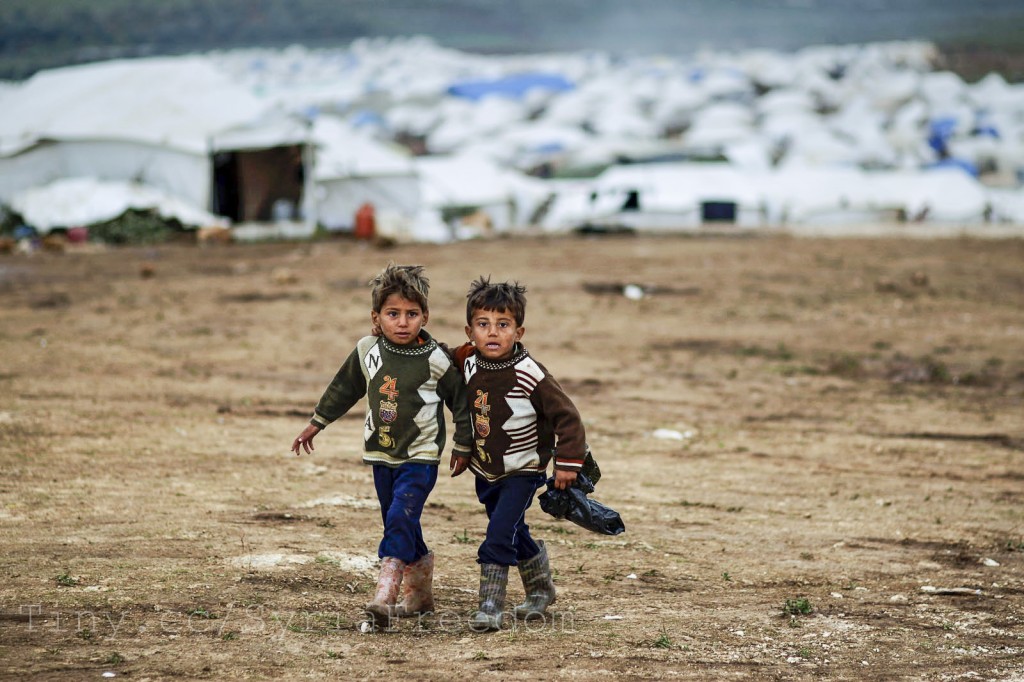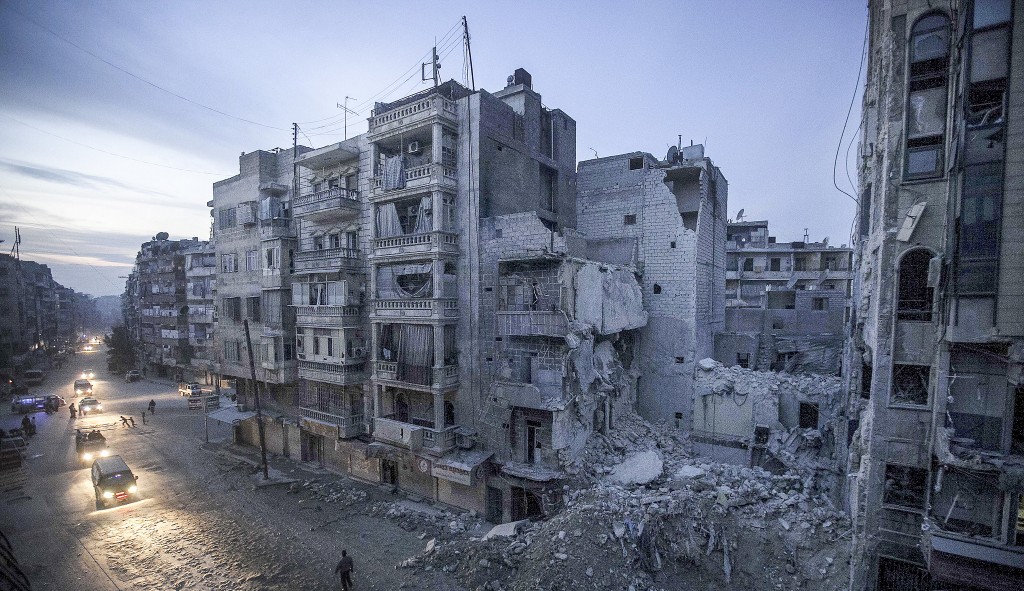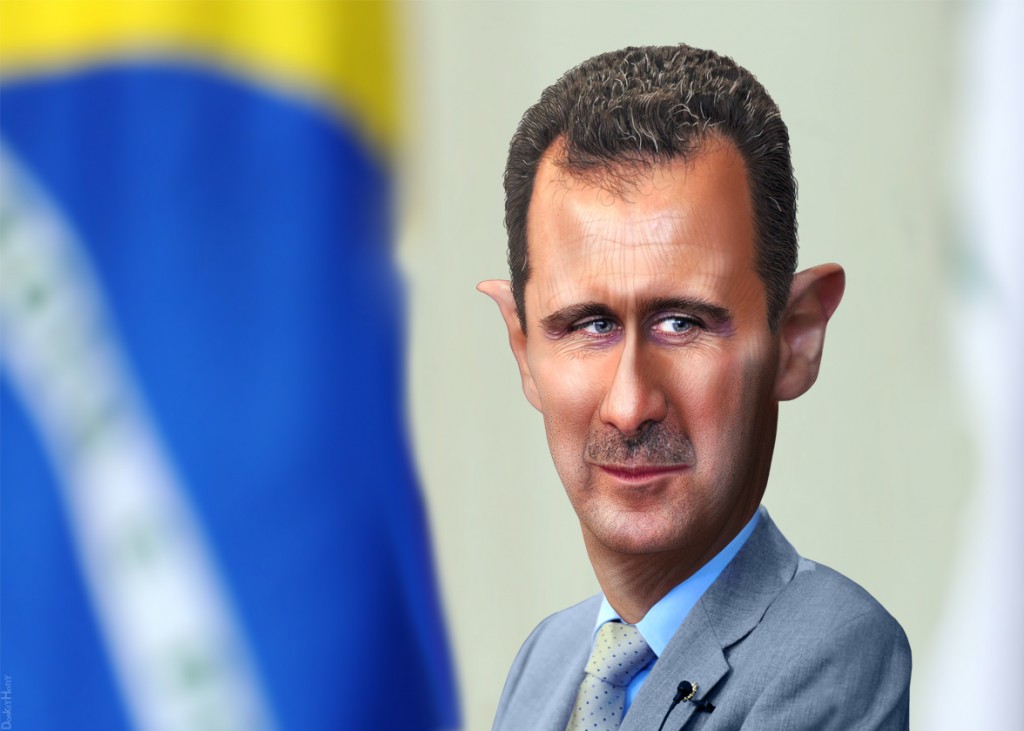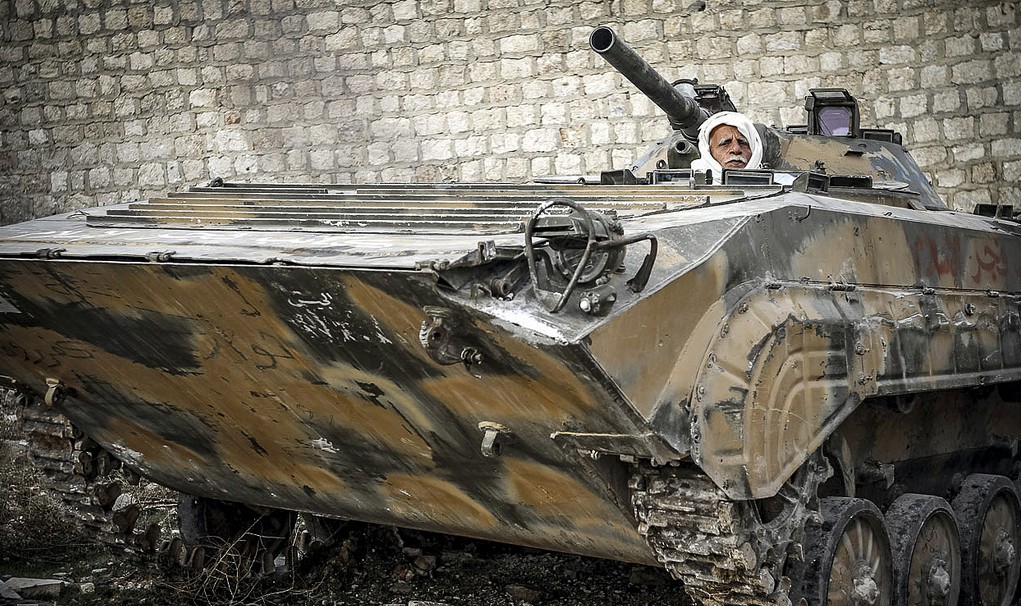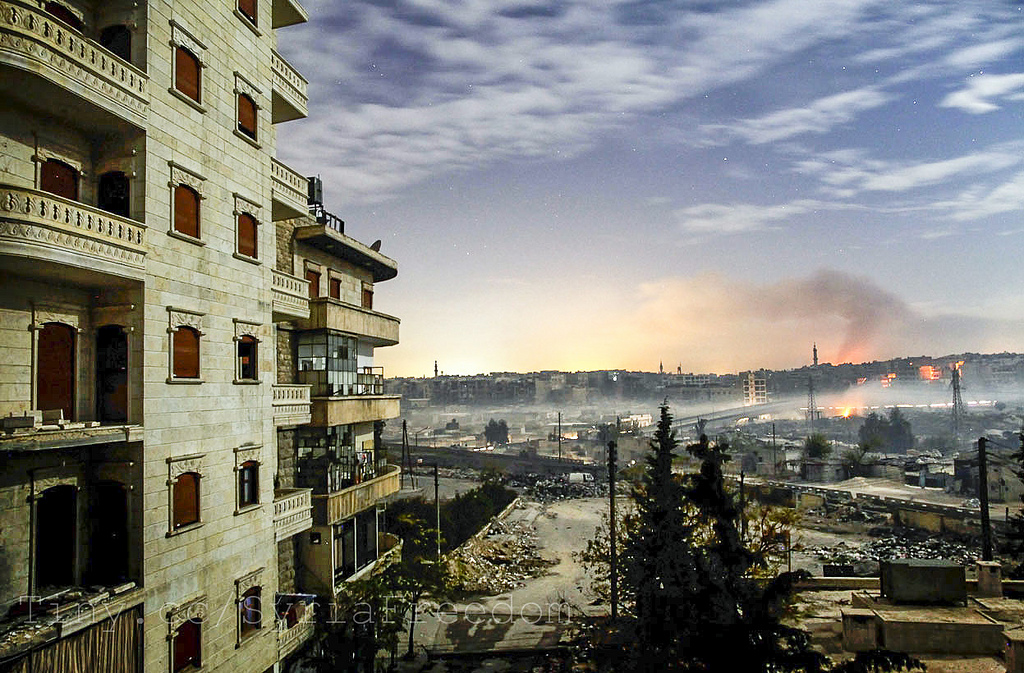Two years and millions of refugees later, Bashar Assad clings to power in one part of Syria, while a disarrayed Islamist rebellion rules another. Can this end well?
The Syrian civil war has now entered its third year with no end in sight. Over 70,000 people have died. 1.5 million refugees have fled Syria, with another two million displaced within the country’s borders. According to the UN, around four million Syrians are in need of aid. Despite gains and losses on both sides, the rebels and the regime of President Bashar al-Assad appear locked in a very bloody stalemate.
At the same time, the reaction of the United States and the Western powers has been extremely troubled. Unlike the regime’s Russian and Iranian allies, which are dedicated to Assad’s survival and willing to take action to ensure his victory, the West’s policy toward Syria has been confused, indecisive, and often self-defeating. While sympathetic to the rebels, the West has not expressed clear support for their cause or provided them with the military aid necessary for victory. Now, even in the face of increasingly strong evidence that the regime has used chemical weapons, the West seems unable to stop equivocating and to take decisive action.
This is not merely problematic. It is also dangerous. The Syrian civil war is only a part of an emerging regional conflict that pits Sunni Muslim nations like Turkey and Saudi Arabia against Shia powers like Iran and its Lebanese-based terrorist proxy Hezbollah. While the Sunni powers certainly have their problems, the Shia bloc is avowedly anti-Western and dedicated to a radical Islamist ideology. The West’s inability to form a coherent policy on Syria makes it look weak and—most importantly—vulnerable to defeat in the eyes of its regional enemies. Like it or not, the West has chosen sides in the Syrian conflict, and if it cannot or will not take the measures necessary to ensure the victory of its allies, it could face potential disaster in the future.
I have witnessed the unfolding tragedy in Syria on three separate occasions over the past year. Each time, I entered the country “illegally,” twice from Turkey in the company of Arab rebels and once from Iraq with Kurdish fighters. The human cost of the war is indeed terrifying. Syria has been transformed into a charnel house, into death’s dominion. It is vital that this not be forgotten amid talk of policy and options—on which this article will focus. The lives of millions of Syrians have been made unlivable and the lives of thousands prematurely terminated by this war.
The military situation continues to ebb and flow. The rebellion now controls a majority of the country’s overall territory, but the regime is not in freefall. Since mid-2012, forces loyal to president Assad have adopted a strategy of abandoning areas that are not essential to the regime’s survival in order to better defend those that are. The result has been the emergence of distinct areas controlled by either the regime or the rebels, with the fighting taking place along the seam lines that separate them. In addition, a de facto Kurdish autonomous zone, allied with the rebels, has emerged in the northeast.
The regime has pursued a ruthless strategy of preventing the development of coherent administration and the possibility of normal life in rebel-held areas. To achieve this, the regime subjects these territories to aerial bombing, shelling, ballistic missile fire, and now, it appears, chemical weapons. This strategy has brought immense suffering to the civilian population in rebel-controlled areas.
Nonetheless, Assad’s decision to reduce his area of control only to those zones essential to his survival appears to have preserved the regime. Despite predictions of its imminent demise, his government does not look to be on the verge of collapse. Indeed, after suffering setbacks in the early part of 2012, with the aid of a 50,000 man Iranian force including thousands of highly-trained Hezbollah fighters, the Syrian regime has achieved significant reversals of rebel gains in recent weeks. Most notably, Assad’s forces and their allies are working to secure the Qusayr area and have retained control of the vital Damascus-Homs highway. They are currently engaged in the expulsion of much of the Sunni population in the area. Many informed analysts believe that this ethnic cleansing, or “purging” as Assad calls it, is part of a larger plan to establish a pro-regime enclave in the western coastal area.
In recent weeks, the Assad has made significant gains in the war of perception, as Western officials struggle to say whether a rapid victory for the rebels would even be a good thing.
Such an enclave would allow for the protection of population groups loyal to the regime. In particular, this would include the 12 percent Alawi minority. Assad and his family are Alawi, and the community constitutes both the regime’s power base and a demographic majority in the western coastal area. It is also likely that Christians and Druze, fearing the victory of Sunni Islamist rebels, would seek refuge in an Assad-ruled enclave.
There are initial indications that Assad, together with Hezbollah, may yet attempt a general offensive to re-conquer lost ground, though it is unclear whether it is in their capability to do so. The rebels, however, remain disunited, and do not appear to be in any position to bring about Assad’s defeat in the near future.
In recent weeks, the regime has also made significant gains in the war of perception regarding the nature of the conflict, which will play an important role in the international response to it. For most of the last two years, both elite and popular opinion in the West has seen the war as that of an insurgency struggling to destroy a brutal dictatorship. In spite of rebel excesses and the presence of extremist al Qaeda-linked Sunni Islamist forces on the rebel side, this perception has largely held. But recent media coverage and statements from western officials indicate that this has started to change. Indeed, several anonymous officials have been quoted suggesting that a rapid victory for the rebels would not be in the interests of the Syrians or the West.
From the beginning, the Assad regime has sought to portray the rebellion against it as a campaign by Islamist “terrorists” seeking to destroy a secular regime that has protected minority communities in Syria. The regime line has been reflected in recent statements by Assad officials. In a New York Times article, Syrian Prime Minister Wael Nader al-Halqi described Syria and the West as “partners in fighting terrorism,” while Information Minister Omran al-Zoubi described the conflict as “a war for civilization, identity and culture. Syria, if you want, is the last real secular state in the Arab world.”
Reporting from the ground on the growing strength of extreme Islamist elements on the rebel side has lent a degree of credibility to this position. This represents a significant advance for the regime in the battle for the “narrative” of the conflict.
What all this adds up to is that, contrary to media reports of rebel advances, the stalemate in the Syrian civil war has not been broken. The two sides each control part of the country. Their competing narratives are swiftly becoming equal in the eyes of the world. Neither is close to dislodging the other.
The West is capable of breaking this stalemate, but has thus far failed to do so.
So what is the West doing about this situation? And do Western countries bear any responsibility for the current state of affairs in Syria?
The policy of the Western powers and particularly the United States on Syria has developed in a confused way, with many stops and starts. Prior to the outbreak of the uprising, the Obama administration and current Secretary of State famously held President Assad out as a reformer and sought to engage him. Remarkably, despite his brutality and overwhelming evidence to the contrary, that impression took a long time to fade. Washington did not call on Assad to step down until August 2011—five months after the resistance had begun—and the U.S. embassy in Damascus continued operations until February 6, 2012. As the situation in Syria transformed from an unarmed uprising to outright civil war in the latter half of 2011, Washington seemed determined above all to avoid entanglement. Instead, the task of supporting the Syrian opposition was farmed out to Washington’s regional allies: Turkey, Qatar, and Saudi Arabia were to play the key roles.
The first attempt to form an umbrella organization for the Syrian opposition began on Turkish soil under Turkish government tutelage, and Turkey gave the opposition a safe haven and permitted its military wing—the Free Syrian Army—to establish itself on Turkey’s southern border with Syria. The formation of the Syrian National Council was announced in Istanbul on August 23, 2011. Meanwhile, as the United States and others Western powers sat on the sidelines, Qatar and Saudi Arabia provided the financing for arms purchases. Starting in late 2011, Saudi and Qatari middlemen were in southern Turkey, making contacts and developing relations with the myriad of small armed groups that the rebellion was producing. Both Riyadh and Doha identified those they regarded as deserving recipients and began to equip their clients.
The results were predictable and significant. Turkey is ruled by a president and a party in sympathy with the Sunni Islamism of the Muslim Brotherhood and outwardly supportive of the terrorist group Hamas. As a result, the political leadership of the Syrian National Council became dominated by the Syrian Muslim Brotherhood and their allies. Qatar and Saudi Arabia showed a preference for Islamist groups of both Muslim Brotherhood and Salafi ideologies. In addition, Doha and Riyadh had an early falling out with each other over the correct strategy for arming the rebels. Qatar followed its usual pattern of supporting organizations linked to the Muslim Brotherhood. The Saudis fear and distrust the Muslim Brotherhood, which they see as a potential threat to the Gulf monarchies.
The result, which was readily apparent by late 2012, was utter confusion. Instead of a coherent, centralized supply line to the Syrian rebels, a clandestine free market emerged in which rival groups sought to market themselves to the Saudi and Qatari representatives active in southern Turkey.
The lack of unity in supplying the rebels was exacerbated by the Syrian opposition’s own failure to unite. The Syrian National Council went through a rapid turnover of leaders and failed to acquire influence among the armed elements inside the country. It soon began to be seen as irrelevant by the U.S. and the West. In an attempt to solve the problem, the SNC was revamped in November 2012, with the establishment of the National Coalition for Syrian Revolutionary and Opposition Forces. It can be argued, however, that the coalition has run into the same problems as its predecessor—namely, accusations of excessive influence from the Muslim Brotherhood and failure to unite the disparate rebel forces.
This only began to change earlier this year. During the first two years of the Syrian civil war, the role played by the U.S. and other Western countries was by choice minimal. It was not until late February 2013 that the U.S. pledged to directly aid the Syrian rebels. Though the West had provided substantial financial aid to the SNC prior to this—in the hope of building up its ability to provide governance and aid in rebel-controlled areas—the U.S. now began to supply “non-lethal” aid to the rebels themselves. U.S. Secretary of State John Kerry stated that this aid would consist of medical and food supplies. In addition, the European Union announced a change in its policy of embargoing military aid to the rebels. Henceforth, EU countries would be permitted to provide “armored vehicles, non-lethal military equipment, and technical aid” to the rebels.
It quickly became apparent, however, that a Western-led operation of considerable scope was working behind the scenes to create order and unity in the rebel camp, as well as ensuring that rebels with whom the West sympathized received adequate weaponry—even if the arms were not directly purchased by the West. This partly covert operation had a variety of elements to it. Most importantly, it involved a major increase in the quality and quantity of weapons made available to the rebels. Qatar and Saudi Arabia still provided the funding, but there was an increasingly direct role for Western countries—in particular, the U.S., Britain, and France—in overseeing the weapons transfers. This followed a covert effort—presumably by Western intelligence services and special forces—to identify “deserving” rebel groups on the ground.
The weaponry entered Syria from Jordan and Turkey, but there appeared to be a preference for Syria’s southern border with Jordan. This was part of a more general strategy. The main rebel gains up to that point in the war had taken place in the north of the country, but this area is also dominated by Sunni Islamist and anti-Western elements. So the decision to channel improved weapons supplies mainly to southern Syria appeared to form part of a strategy in which the more problematic groups in the north were to be bypassed in favor of less ideological rebels in the south. This strategy was presumably based on the hope that the southern rebels would be able to launch a swift assault on Damascus, effectively making them masters of Syria.
The West had hoped to aid “secular” rebel forces. But by the time the West finally chose to act, such forces simply did not exist.
This strategy was overly optimistic and did not work out as planned. The rebels in the south did make significant gains in the first months of 2013 and, for a moment, looked like paving the way to a push on Damascus. But the regime did not collapse, and with increasing opposition from Iranian forces, the rebels’ advance rapidly ground to a halt.
In addition, researchers tracing the movement of weaponry in Syria found that, predictably, efforts to keep the new weapons from reaching jihadist rebels in the west and north of the country have been unsuccessful. The reality is that many of the most active and determined rebel groups adhered to jihadist ideologies and weaponry tends to find its way to the people most prepared to use it. These include some of the most extreme rebel groups.
The West’s change in policy also failed because of another crucial factor: The West hoped to aid “secular” rebel forces, but it was apparent to close observers that by the time the West finally chose to act, such forces simply did not exist.
By early 2013, the rebels had solidified into a number of alliances, organized along broadly ideological lines. Three of them had risen to dominate the rebellion. The most extreme is the Jabhat al-Nusra group, which openly declares itself the representative of al-Qaeda in Syria. It is among the most active rebel units and armed by Qatar and Turkey, is thought to number around 6,000 fighters. In addition, there is the Syrian Islamic Front, which brings together a number of Islamist groups, the largest of which is the Ahrar al-Sham organization, thought to be supported by Saudi Arabia and Kuwait. This bloc probably numbers around 15,000 fighters. By far the largest rebel alliance is the Syrian Islamic Liberation Front, which brings together fighters from several of the most powerful non-Salafi groups in Syria. It has somewhere between 35-40,000 fighters.
These are the main groups among the rebels. There is no alternative secular rebel alliance on the ground.
Western policymakers’ vacillating and half-hearted approach to the conflict must take a significant amount of responsibility for this unwanted outcome. U.S. and Western policy on Syria has been largely influenced by its reluctance to become embroiled in a new Middle East war and its determination to avoid direct intervention. This has led to a deeply divided insurgency in which Sunni Islamists, each more radical than the next, and sponsored by the competing regional forces that have performed the “heavy lifting” of supporting the rebels, are now dominant.
It remains to be seen whether the latest revelations regarding the regime’s use of chemical weapons will shift U.S. policy toward a more active stance, but the signs are not encouraging. The latest statements from the Obama administration indicate a further qualification of its “red line” on the issue. It is now the “systematic” use of such weapons that constitutes the “game changer,” rather than their “movement,” as initially outlined, and later their use in and of itself.
It seems, then, that the U.S. and the West in general are likely to continue their previous approach to the conflict. This is unfortunate, because the desire to avoid direct involvement and outsource their support for the rebels, such as it is, has produced two main results: The domination of the uprising by Sunni Islamists and the survival of the Assad regime.
Western indecisiveness is particularly problematic because it stands in sharp contrast to the approach adopted by Assad’s allies—Russia and Iran chief among them. Assad has benefitted immensely from having a small but extremely effective group of allies with a clear and simple agenda: To keep him and his regime in power. Unlike the West, these allies have maintained a consistent and determined stance throughout the conflict.
Russian support in particular has been invaluable to the regime. Russia’s veto at the UN Security Council has prevented any effective UN action against Assad. In addition to diplomatic cover, Russian cash and arms supplies have enabled Assad to survive economic sanctions and continue the conflict militarily.
Russia has strategic reasons for supporting Assad. A recent article in the Guardian notes that the naval base at Tartous, its only remaining outpost beyond the former USSR, allows the Russian Navy to operate in the Mediterranean, as well as have easy access to the Red Sea via the Suez Canal, and the Atlantic Ocean via the Straits of Gibraltar. It also appears that President Vladimir Putin sees relations with the West as a zero-sum game. If Moscow is able to make the West look hapless and weak by defending its own client to the hilt, this is a positive development from Putin’s point of view. As a result, Russian support for the regime remains and likely will remain firm and unwavering.
Next to Russia, Iran is Assad’s most important ally, along with its terrorist army Hezbollah. From the beginning, Tehran has provided equipment, money, arms, and manpower to the dictator. As early as April 14, 2011, U.S. officials confirmed that Iran was aiding in the repression of what was then a mostly non-violent uprising. A classified United Nations report from early 2012, eventually leaked to the media, stated that Iran was by then covertly shipping arms to Syria in violation of international sanctions. Iran has also provided support through its paramilitary Quds Force, a special unit of the Iranian Revolutionary Guard Corps. Israeli military intelligence officials have said publicly that Iran is working to deploy an armed force of 100,000 in Syria, and is already more than halfway there.
Teheran has also enlisted other allies from the regional bloc it leads. The Iraqi government of Nuri al-Maliki, for example, has made its territory available for weapons transfers and acted as a go-between for funneling financial support to Assad. It has done so together with Iran’s terrorist proxy Hezbollah, which has provided access to Beirut’s financial and banking system, as well as occasionally acting as agents for the sale of sanctioned Syrian oil.
Iran’s use of Hezbollah has also been a major source of military support for the regime. Thousands of Hezbollah men have been observed fighting in Damascus and the Qusayr area, both of which are essential to the regime’s survival, and seem to have been invaluable in helping Assad develop new and more useful military capabilities. In particular, the evidence suggests that—with the aid of Hezbollah and Iran—Assad has created a new, sectarian paramilitary force. Developed from the Alawi irregular fighters of the “Shabiha” group, it is known as the National Defense Force and is staffed mainly by Alawis and other minorities. Its emergence testifies to the regime’s new ability to adapt to changing circumstances—in contrast to the rigid, Soviet-influenced system that preceded the uprising.
All this determined activity by Iran, its allies, and Russia has been far more effective than the vacillating policy of the West. Indeed, it is the key element to the dictator’s survival. The regime’s allies have from the outset been determined and implacable. They have pursued a clear goal using creative, ruthless, and flexible methods. The supporters of the rebellion, by contrast, have been disorganized, hesitant, and uncoordinated. The rebels have made gains in spite of this because of their own determination and the support, overt or covert, of a large portion of the population. But the regime has managed to survive and shows no signs of imminent collapse. The main reason for this is that Assad’s allies know what they want and are determined to get it, which is not true of their rivals.
Where have the rebels’ failures, the hesitant support of their allies, and the resolution displayed by Assad and his supporters led us? It has resulted in a situation in which the Syrian conflict has become a full-fledged sectarian civil war with grave regional implications. It pits a non-Sunni regime backed by the leading Shia power in the region—Iran—against a Sunni rebellion backed by the most dominant Sunni powers—Turkey, Qatar and Saudi Arabia.
This means that the Syrian civil war is no longer a localized conflict. It has potentially serious repercussions for the entire Middle East. It is now the hottest point in an emerging Sunni-Shia and Sunni-Sunni conflict that is sweeping the region. Indeed, it has already spread both east and west. In Lebanon, the Shia group Hezbollah is fully and actively committed to the cause of the regime, while Sunni forces are supporting the Syrian rebellion. In Iraq, the Shia-dominated government supports Assad while Sunnis in the restive Anbar and Nineveh provinces are collaborating with Syrian rebels across the border. On an ideological level, the Syrian civil war serves as an inspiration to Sunni forces seeking to challenge Shia control of Iraq.
Even in areas not directly affected by the Syrian situation, the Sunni-Shia rivalry is heating up. In Bahrain, Yemen, and eastern Saudi Arabia, Sunni and Shia Arabs are in conflict. Iran is backing the Shia forces in all these cases, while Saudi Arabia, Qatar, and Turkey are backing the Sunni forces.
This growing Sunni-Shia military conflict is, in many ways, the result of U.S. policy in the Middle East over the last half-decade. By ending its support for U.S.-allied regimes in Tunisia and Egypt, the U.S. enabled Sunni Islamist governments to rise to power in these countries. In the past, Riyadh assumed that the U.S. would do the work of opposing threatening forces in the region. Now, the Saudis realized, they would have to do it themselves. Sunni unrest also provided an opening for Qatar to pursue its regional ambitions, which are mostly aligned with the most radical elements of the Muslim Brotherhood—including in Syria. Similarly, U.S. inaction on the Syrian rebellion has allowed the civil war to become defined by this larger Sunni-Shia conflict. In particular, the preferences of the West’s proxies—Turkey, Qatar, and Saudi Arabia—has led to the undisputed domination of the rebellion by Sunni Islamist forces of various hues.
Put simply, the West’s Sunni proxies are not strong enough to defeat the Assad regime. And they are dominated by people committed to creating an Islamist, Sunni state that would be a disaster.
This is not only a political and ideological problem; it is also a practical one. Put simply, the West’s Sunni proxies cannot produce positive results. The insurgency they have created is not strong enough to defeat the Assad regime and its determined backers. And the forces that have flourished among the rebels because of those proxies are dominated by those committed to the establishment of a militant Sunni Syria that would likely be disastrous for Syria’s non-Sunni population.
All of this puts the U.S. in an extremely difficult position. Because Washington has offered clear verbal support to the rebel side, it once again looks weak and ineffectual in the eyes of both allies and enemies in the region. This impression has only been strengthened by the apparent ineffectuality of the Obama Administration’s “red lines” on chemical weapons. The Syrian experience shows that the U.S. and the West in general cannot rely on local Sunni clients to preserve Western interests in the face of an openly anti-Western Shia bloc led by Iran and its global allies.
Instead, U.S. disengagement from the region is producing both a regional Sunni-Shia confrontation, and a growing conflict between Sunni states more aligned with the U.S — Saudi Arabia, the UAE and Jordan — versus a Sunni extremist axis led by Qatar, and comprised of Turkey, Muslim Brotherhood-dominated states including Egypt, and their Hamas allies. A senior Arab official from the U.S.-oriented Sunni faction recently described his government’s relationship with Qatar to the Wall Street Journal. “We have pretty fundamental disagreements on policy. We simply believe in different philosophies,” he explained. “We believe in secularism and they support political Islam. We believe in picking sides; they believe in picking both sides.”
It is, of course, reasonable to ask whether the emergence of a Sunni-Shia confrontation is in itself a cause for concern. It obviously has severe consequences for the Arab world, but does it matter to the West? If the Middle East becomes an arena for sectarian competition, struggle, and war, is this a serious threat? Or can it be largely ignored, much as the Western world ignores the massive violence and political dysfunction prevalent in sub-Saharan Africa?
To answer this question, one must understand that a region dominated by sectarian conflict abhors a vacuum. If the rebels’ allies will not act to control and define the conflict, Assad’s allies will happily do so instead. And thus far they have done so quite successfully. If the regime survives, even in only those parts of Syria deemed essential by Russia and Iran, this will represent a highly visible victory for an alliance of declared enemies of the West. A victory won against an alliance of Western clients, albeit with deeply problematic elements.
Following the collapse of pro-U.S. regimes in Egypt and Tunisia, an Assad victory would further be seen by political elites across the Middle East as an object lesson. The lesson will be that allying with the U.S. is an error. The U.S. will not back you in your moment of need, while opposing it and allying with its enemies carries little cost. The U.S. and its regional allies, it will be believed, can be successfully challenged as long as you have determined allies of your own prepared to back you to the hilt. And such determined allies can be easily found in Iran and Russia.
Should evidence of American weakness become so readily apparent, it would have several practical effects: First, Iran will be encouraged to even more strenuously defy the West over its nuclear program, secure in the knowledge that U.S. and Western threats can be faced down. In the longer term, an Iranian victory in Syria and a general sense that the U.S. and its allies are a spent and declining force will fuel the idea of Iran and its allies as a “resistance bloc” that can effectively defeat a collapsing West. In turn, this could result in a regional shift in favor of Iran, with such states as Qatar and possibly even Muslim Brotherhood-oriented regimes such as Egypt and Gaza cementing a tilt in favor of the Islamic republic. That this is a potential catastrophe for the West should be obvious.
Unfortunately, it is true that the dominant Sunni rebels in Syria do not represent a chance for better government and economic development. But this is something the West must accept. The war in Syria represents a point at which the advance of forces overtly hostile to the West is either stopped by determined resistance or wins a resounding victory that will set the stage for further advancement—and, as a result, more chaos, violence, and war. It must be acknowledged that the forces prepared to align with the West are deeply problematic. But this is one of those moments when the question is one of alignment, not ideological sympathy.
Until now, the U.S. and the West have completely failed to meet this challenge. They have neither opposed their enemies nor supported their allies effectively. As of now, the Assad regime is standing firm and even regaining lost ground. Its survival, which means its victory, would be a disaster for the West. It is crucial, then, for the West to take those measures necessary to prevent it and to end the carnage in Syria in the shortest possible time. This is a strategic imperative of the utmost urgency for America, the West and its allies in the Middle East.
![]()
Banner Photo: FreedomHouse/Flickr






